IUCN/SCC Otter Specialist Group Bulletin
©IUCN/SCC Otter Specialist Group
Volume 23 Issue 1 Pages 1 - 48 (April 2006)
Citation: Karami,M., Mirzaei, R. & Hamzehpour, M. (2006) Status Of Eurasian Otter (Lutra lutra) in Iran IUCN Otter Spec. Group Bull. 23 (1): 28 - 34
Previous | Contents | Next
Status Of Eurasian Otter (Lutra lutra) in Iran
Mahmud Karami1, Roohallah Mirzaei2 and Mona Hamzehpour3
1 Campus of Natural Resource, Tehran University, e-mail: mkarami@chamran.ut.ac.ir
2Senior Expert, Tehran University, E-mail:i_mirzaei@yahoo.com
3Senior Expert, Islamic Azad University
|
 |
 |
Abstract: There have been no comprehensive reports on the distribution of Eurasian Otters in Iran. A research program to fill this gap has been instigated. This report presents the results of a literature review, and interviews with otter-aware individuals to summarize the state of knowledge about Eurasian Otters before the new survey begins. |
INTRODUCTION
Eurasian Otters are distributed through most of Iran’s aquatic ecosystems. Since there are no comprehensive reports on their occurrence, Dr. Karami (Tehran University) decided in 2005 to start studying the species in this country. He therefore instigated two theses on this. In this report we review all information about the species in Iran, and we later hope to publish scientific articles about the status of Eurasian otter in Iran.
DISTRIBUTION
Review of scientific sources and interviews with otter-aware people clearly showed that the Eurasian Otter lives in most of the aquatic ecosystems of Iran. Extensive distribution, however, does not mean the species has a high population or high density. The species is found in most of Iran’s rivers, lakes, pools, etc. such as Gilan, Mazandaran, Azarbayejan, Tehran, Kordestan, Kermanshah, Markazi, Isfahan, Khorasan, Chaharmahal-Bakhtiari, Fars, Khozestan, and Lorestan provinces (Kiabi, 1993). Eetemad (1984) in his study of the physical and morphological characteristics of the Eurasian Otter referred to the subspecies L. l. seistanica and L .l. meridionalis. The first subspecies was found in most areas referred to in the text above. The second subspecies was found only on the banks of the Heermand River (Eetemad, 1984). Dr. Kiabi in 1993 introduced the Eurasian Otter in Aquatic Organisms Magazine, in which the distribution was described (Kiabi, 1993; Figure 1). Later, when discussing mainly Smooth-Coated Otter in the Haw-al-Azim wetland, Eurasian Otters were also covered (Ziaee, 1996). Mirzajanei (1998) referred to locations where Eurasian Otters are found in Iran, including biometry of dead animals from various locations.
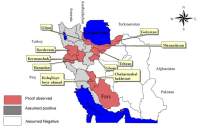 |
| Figure 1.Map of Eurasian Otter Distribution in Iran (Mirzaei, 2006). Click on image for larger version |
Mona Hamzehpour is working on a study of the presence, distribution and population density of Eurasian Otters in Deylaman-Dorfac hunting-prohibited area, where she found a number of otter-signs (spraint and tracks) on the long Shenrood river, where she live-trapped an otter, releasing it four months later.
We also understand from interviews with the Environment Department’s specialist in Malayer, that the species occurs in Hamedan province.
It therefore appears that Eurasian Otters are well distributed in our country, but we should begin an orderly and systematic program for studying population densities and distributions so we can regulate management actions. The information available already today is summarized below (Table 1):
| Table 1:
Some information about researchers who study Eurasian Otters in Iran |
| Area Monitored |
Name of Researcher |
Date of Study |
All of Iran |
E. Eetemad |
1984 |
All of Iran |
B.H. Kiabi |
1993 |
Haw-al-Azim wetlands (Mesopotamian) |
H. Ziaei |
1996 |
Mahabad Dam, Sefidrood River, Anzali wetland & Kermanshah |
A. Mirzajanei |
1998 |
Jajrood River, Tehran |
R. Mirzaei |
2005-2006 |
Shenrood River |
M. Hamzehpour |
2005-2006 |
Shafarood River, Gilan |
M. & M. Ershad |
2006 |
|
BIOMETRY
Very little information on the biometry of Eurasian Otter in Iran is available (Tables 2, 3).
| Table 2 :
Characteristics of Otters from different areas in Iran |
| Province |
Area of capture |
Head and body (cm) |
Tail (cm) |
Back foot (cm) |
Ear (cm) |
Sex (m/f) |
Mazandaran |
Neka River |
68 |
40 |
9 |
- |
f |
Gilan |
Sangar Dam |
66 |
39 |
12 |
2 |
f |
Golestan |
Gorgan |
43.5 |
27 |
10.5 |
1.7 |
f |
Tehran |
Jajrood River |
71 |
41 |
21 |
- |
f |
Gilan |
Shenrood River |
67 |
42 |
18.5 |
1 |
f |
|
| Table 3:
Some Information about two Otters from Anzali and Kermanshah. |
Measurement |
Anzali Wetland |
Kermanshah |
Length of skull |
10.80 |
11.62 |
Width of mastoid |
6.40 |
7.11 |
Distance between eyes |
1.5 |
1.51 |
Length of nose |
4.05 |
3.60 |
Width of zygomatic |
7.69 |
7.12 |
|
REPRODUCTION
We do not have any information about timing of reproduction.
FOOD HABITS
Diet has been investigated on the Jajrood River during the current study (Table 4) (Mirzaei, 2005).
| Table 4:
Food diet of Eurasian Otters on the Jajroor River during a year |
| Prey |
Frequency (%) |
Fish |
90.76 |
Crabs |
3.66 |
Birds |
3.58 |
Insects |
2.00 |
|
PARASITES
Mona. Hamzehpour recorded parasites of the otter in her thesis (Table 5) (Hamzehpour, 2005).
| Table 5:
Parasites of otters found by examination of 158 spraints in Deylaman-Dorfak hunting-prohibited area |
| Parasites |
Number |
Isospora spp. |
4 |
Fasciola hepatica |
86 |
Trematode egg |
837 |
Nematode larva |
183 |
Nematode egg |
388 |
Capillaria spp. |
2391 |
|
THREATS
Eurasian Otters have been hunted cruelly in our country because of their economic value, and because they are piscivorous carnivores.
In Iran, the species has been hunted to protect fish farms, and for their pelts for sale, for taxidermy and for decoration in houses and shops. In the provinces in the north of Iran, where the habitat is especially suitable for otters, they are common as taxidermic mounts. On fish farms, they are hunted with traps, electric fencing and weapons, and this is an important factor in reducing numbers. In one fish farm pool, five otters died due to electric fencing in only 2 years, and 2 died similarly in Tehran. In the north, otters are drowned in fishery nets, whereas in the central provinces, habitat destruction and riverbank degradation are the problem. We do not have any information about otter deaths due to pollution.
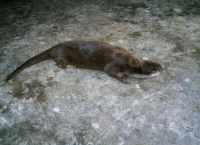 |
| Figure 2. Live otter from Deylaman-Dorfak hunting-prohibited area (Hamzehpour, 2005) . Click on image for larger version |
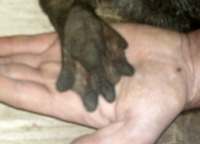 |
| Figure 3. Hand of live otter from Deylaman-Dorfak hunting-prohibited area (Hamzehpour, 2005). Click on image for larger version |
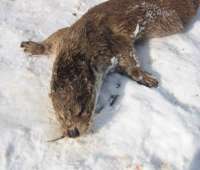 |
| Figure 4. Otter from Jajrood River (Mirzaei, 2005). Click on image for larger version |
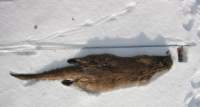 |
| Figure 5. Otter from Jajrood River (Mirzaei, 2005). Click on image for larger version |
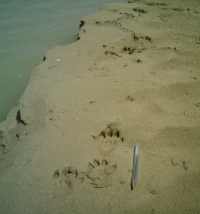 |
| Figure 6. Footprints of an otter on bank of Jajrood River (Mirzaei, 2005). Click on image for larger version |
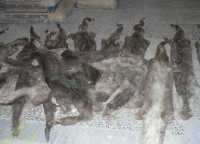 |
| Figure 7. Some otter skins from Golestan National Park (photo: Khosroshahi, 2006). Click on image for larger version |
ACKNOWLEDGMENTS - We thank Yossi Ben-Ari and Ashael Raveh for their assistance in the field-work and Ayelet Sapir and Guy Nizri (GIS division, SPNI) for preparing the map. The field survey was supported by the Nature and Parks Authority.
REFERENCES
Eetemad, E. (1984). Iran Mammals. Department of Environment, Vol. 2, 104 - 112.
Gutleb, B., Rautschka, R. & Gutleb, A.C. (1996). The otter (Lutra lutra) in Iran. IUCN Otter Spec. Group Bull. 13: 43-44.
Hamzehpour, M. (2005). Study on the presence, distribution and density of Eurasian Otters in Deylaman-Dorfak hunting prohibited area, Gilan province. Thesis of Senior Expert, Azad University, Tehran.
Kiabi, B. (1993) Otter. Aquatic Species Magazine 6: 10-15.
Mirzaei, R. ( 2006). Study of Factors Threatening Otters (Lutra lutra) on the Jajrood River in Tehran Province. Thesis of Senior Expert, Campus of Natural Resources, Tehran University.
Mirzajanei, A. (1998). Looking at the Status of Otters (Lutra lutra). Environment Magazine 25: 70-74.
Ziaee, H. (1996) Field Guideline of Iran Mammals, Department of Environment, pp 208 - 220.
Previous | Contents | Next
|









